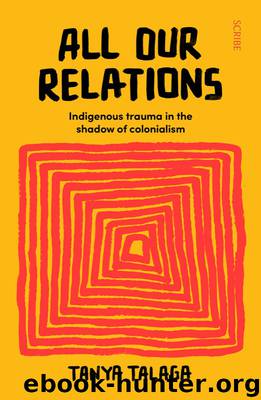All Our Relations by Tanya Talaga

Author:Tanya Talaga
Language: eng
Format: epub
Tags: SOC062000, SOC031000, SOC021000, SOC002010, PSY037000, POL029000, MED036000, POL035010, HIS028000, HIS038000, HIS054000, SOC036000
Publisher: Scribe Publications Pty Ltd
Published: 2020-01-08T16:00:00+00:00
FOUR
“I BREATHE FOR THEM”
ON JANUARY 22, 2018, a snowstorm raged outside, while inside the Wabano Centre for Aboriginal Health in Ottawa, a forum of First Nations, Inuit, and Métis youth had been brought together by We Matter, a national Indigenous-led non-profit organization started by a sister-and-brother team from Hay River, Northwest Territories. The Attawapiskat suicide crisis in James Bay had motivated Tunchai and Kelvin Redvers to establish the youth empowerment group. Using a social media model similar to the It Gets Better Project in the United States, which offers LGBTQ+ youth support, We Matter uses multimedia — videos, art, writing — to send positive messages to youth from Indigenous role models and allies.
The Wabano Centre provides holistic, culturally relevant health services to First Nations, Inuit, and Métis communities of Ottawa and is housed in a beautiful twenty-five-thousand-square-foot building designed by renowned Indigenous architect Douglas Cardinal. A majestic stone staircase leads up to a smooth curvilinear structure, Cardinal’s signature. The main floor, called the Water Floor, contains prenatal and primary care clinics and a Cedar Lodge used for sweats. Walk up the stairs to the second floor, the Fire Floor, and you’ll see a giant domed ceiling featuring a beautiful medicine wheel illuminated by a skylight. Look down and you’ll see that the red- and earth-toned floor tiles are shaped in the pattern of a Star Blanket. The Star Blanket is traditionally given to honour people at pivotal stages of life, such as birth or marriage. If you stand at the centre of the star and speak out, your voice echoes throughout the room.
The Fire Floor features Wabano’s Grand Gathering Space, and this is where nearly ninety youth had gathered together with politicians — including the national chief of the Assembly of First Nations, Perry Bellegarde, and Canada’s Indigenous Services minister, Jane Philpott — and representatives of Facebook to talk about how suicide had affected the youth and their communities. Facebook is a prominent tool of communication in isolated Indigenous communities, and the social media powerhouse was in attendance because of its unique capability of detecting suicidal behaviour online. A microphone was passed around the circle.
Jenna, from a Mi’kmaq community in Halifax, told the group she had recently lost her cousin, who had struggled with anxiety and depression: “He was a mixed martial arts fighter, twenty years old, a firefighter. He reached out. If we had culturally appropriate mental health care, I think he’d still be here today. He took his life after he was given a two-month wait time [for treatment]. We can’t stop fighting.”
Lori, also a Mi’kmaq from Nova Scotia, said, “A lot of us here have undergone trauma — sexual violence, violence, abuse — from family members, people who are supposed to be our friends.”
Matthew, a Haida Gwaii youth from British Columbia, called suicide the darkness “bringing us down. I have thought about it more than once. We all have one thing in common: we are all suffering. My thirteen-year-old sister ran away. We have fear and shame that we all hide.
Download
This site does not store any files on its server. We only index and link to content provided by other sites. Please contact the content providers to delete copyright contents if any and email us, we'll remove relevant links or contents immediately.
| Grief & Bereavement | Hospice Care |
| Pet Loss | Suicide |
They Both Die at the End by Adam Silvera(9720)
Thirteen Reasons Why by Jay Asher(8792)
The Space Between by Michelle L. Teichman(6855)
Suicide Notes by Michael Thomas Ford(4763)
Tuesdays with Morrie by Mitch Albom(4688)
Suicide: A Study in Sociology by Emile Durkheim(2971)
The Checklist Manifesto by Atul Gawande(2776)
Tuesdays With Morrie by Mitch Albom(2693)
In the Woods by Tana French(2532)
Bossypants by Tina Fey(2464)
Robin by Dave Itzkoff(2383)
Olive Kitteridge by Elizabeth Strout(2306)
No Ashes in the Fire by Darnell L Moore(2297)
Reservoir 13 by Jon McGregor(2241)
End of Days by Sylvia Browne(2117)
All Things New by John Eldredge(2102)
Bus on Jaffa Road by Mike Kelly(2101)
Scar Tissue by Anthony Kiedis(2089)
No Time to Say Goodbye(2057)
